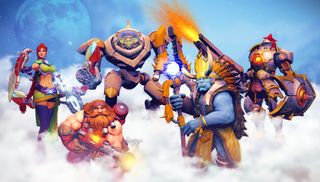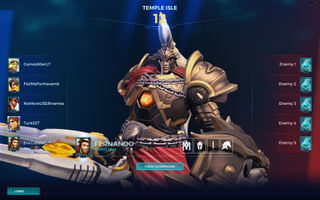Paladins isn't Overwatch, but it is pretty mediocre right now
A jumble of characters and soft weapons has Paladins off to an underwhelming start.

What is Paladins' place in the growing pantheon of 'hero shooters'? Whatever we're calling this genre, there's clearly room for more. Paladins is already drawing tens of thousands of concurrent players on Steam, currently more than Hi-Rez Studios' MOBA-inspired multiplayer game, Smite.
Right now, Paladins is 17 characters, a handful of maps, and the option to play five-on-five in either ranked or casual matchmaking. After spending some time with it this week, I'm cold on it. The combat doesn't have the sense of physicality that I want in a multiplayer FPS. The maps are simple, in terms of art and layout. Yes, yes, it's a beta, but it's also a free-to-play game that's currently selling its entire roster of characters—present and future—for $13/£11.
Across the board, weapons and abilities lack weight.
One of my main complaints is how strategically shallow Paladins feels so far. I haven't identified clear, interesting counters between characters, or had many exciting duels where I outwit someone by exploiting aspects of the map. Chalk up some of that criticism to the inexperienced players I've been matched against in quick play—I've won all of the dozen-some matches I've been in. And although I've only been playing for two days, the prerequisite to ranked play seems needlessly steep: even with the paid Founder's Pack, you have to take 12 champions up to mastery level four in order to unlock Paladins' competitive mode.
(Update: Paladins' quick play matches you against AI until you're level five, which isn't explicitly stated (the menu says "against players"), so take my comment about strategic depth with a grain of salt.)
Watching some experienced streamers, like WiFighter, I see that some characters can be played quite acrobatically, and that there's a higher skill ceiling than the one I've been bumping my head against. Androxus, the revolver-wielding demonic champ, can dash into the air three times and glide down while gunslinging. Skye is a speedy harasser who uses invisibility to deke out of danger. When archer Cassie dodge-rolls, it boosts the damage of her next shot by 30 percent.
But one of the issues I have with Paladins right now is how hollow these weapons and techniques feel in your hands. Across the board, weapons and abilities lack weight, inertia, and physicality. When I burn someone with Fernando's flamethrower, they don't ignite. Almost no projectiles bounce or ricochet. Buck's net attack, an alt-fire on his shrapnel shotgun, just vanishes when it collides with an enemy, like it's a spell rather than a web of rope. Some ultimate abilities lack a big, splashy particle effect or animation paired with them.

Champion soup
Maybe the underlying problem is how incohesive the kitchen-sink cast of characters are. Buck, a self-healing shotgunner, is a armored monk who can leap far. Ruckus, a tiny goblin inside an enormous mech, inexplicably rides the same horse mount that other characters do. Bomb King, who sort of plays like Team Fortress 2's Demoman, seems more at home in Dragon Quest. There's of course a precedent for whimsical, weird heroes in League of Legends and other competitive games, but Paladins' assortment of sci-fi and fantasy doesn't feel united by a shared idea or theme.
The biggest gaming news, reviews and hardware deals
Keep up to date with the most important stories and the best deals, as picked by the PC Gamer team.
It might help if Paladins explained how these characters came together or what they're fighting for. The champion selection screen and official website do not dole out a crumb of story. One of the key lessons from TF2, which Hi-Rez cites as a primary inspiration, was the value of establishing relationships between characters to give matches a greater sense of meaning. The Soldier and the Demoman were roommates. The Spy had sex with the Scout's mom. The Heavy doesn't just shoot a minigun, he shoots Sasha. Folding a narrative into a multiplayer shooter takes time, but it can also be sprinkled: Overwatch gets mileage out of its quick lines of pre-match dialogue.

As it enters an increasingly crowded genre, it's key that Paladins establishes a strong identity. Despite the many comparisons to Overwatch, its ratio of MOBA and FPS ingredients is unique. I appreciate that Paladins isn't burdened by gimmicks or frills: there's no jungle, power-ups, or convoluted modes: just capture points, a payload, and five-on-five fighting. Its cards system is a lightweight nod to the item systems of MOBAs, but it doesn't detract from skillful play.
With Smite, Hi-Rez had a clear and compelling pitch: an action-MOBA populated by familiar and exotic gods, played over the shoulder of your character. As I keep playing Paladins, I'm yet to find an equally strong, distinguishing quality.

Evan's a hardcore FPS enthusiast who joined PC Gamer in 2008. After an era spent publishing reviews, news, and cover features, he now oversees editorial operations for PC Gamer worldwide, including setting policy, training, and editing stories written by the wider team. His most-played FPSes are CS:GO, Team Fortress 2, Team Fortress Classic, Rainbow Six Siege, and Arma 2. His first multiplayer FPS was Quake 2, played on serial LAN in his uncle's basement, the ideal conditions for instilling a lifelong fondness for fragging. Evan also leads production of the PC Gaming Show, the annual E3 showcase event dedicated to PC gaming.
Most Popular

